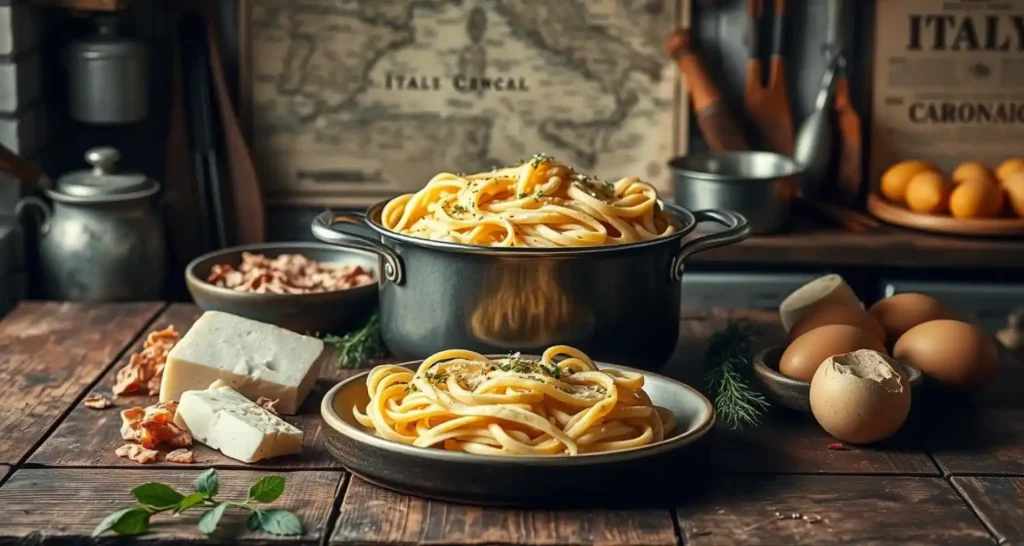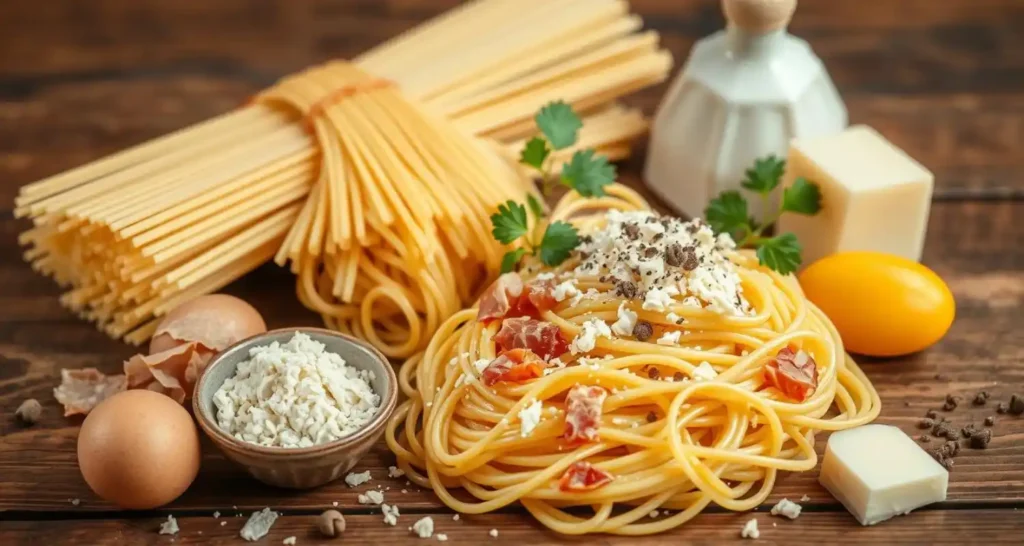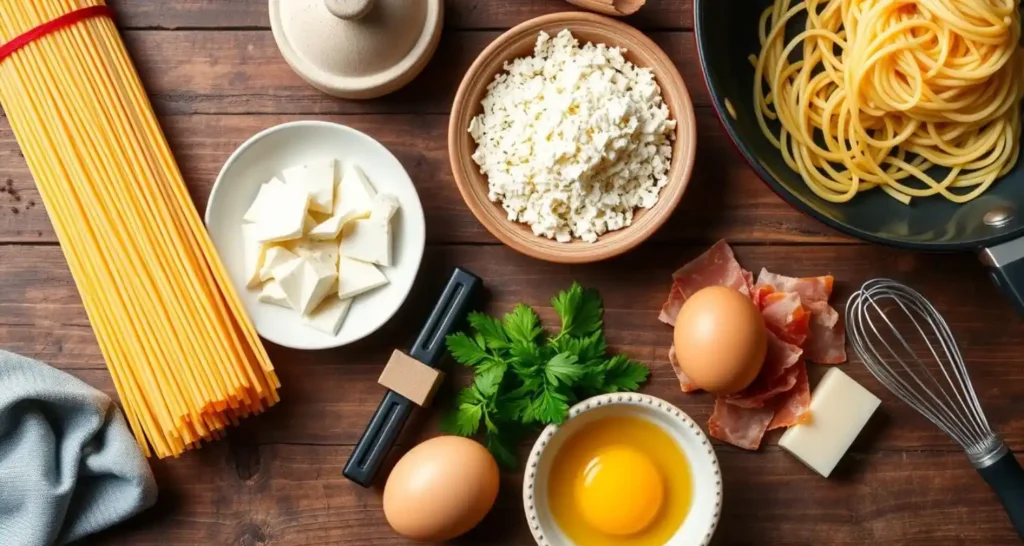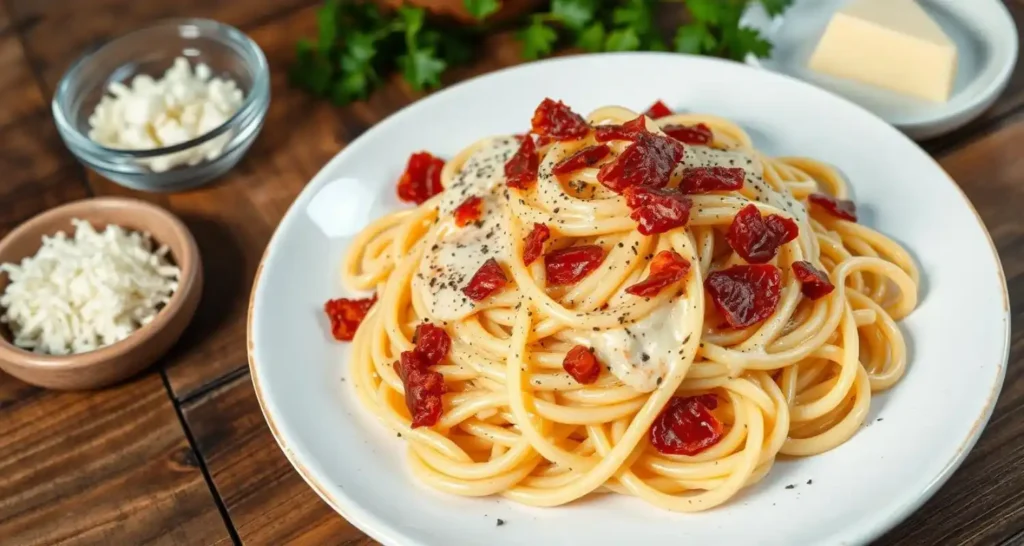
Classic Italian Pasta Carbonara
Equipment
- Large pot
- Heavy skillet or saucepan
- Mixing bowl
- Whisk
- Tongs
- Microplane grater optional
Ingredients
- 8 oz spaghetti or bucatini
- 3 large eggs
- 1 cup Pecorino Romano cheese grated
- 4 oz pancetta or bacon diced
- 1/4 tsp freshly cracked black pepper
Instructions
- Boil a pot of salted water and cook the pasta until al dente. Reserve 1 cup of pasta water before draining.
- Whisk together eggs, Pecorino Romano, and black pepper in a mixing bowl.
- In a skillet, cook pancetta or bacon over medium heat until crispy. Remove and leave the fat in the pan.
- Toss the drained pasta in the skillet with the pork fat to coat.
- Remove the skillet from heat. Gradually mix in the egg-cheese mixture, stirring continuously to create a creamy sauce. Add reserved pasta water if needed for consistency.
- Mix in the crispy pancetta and serve. Top with more Pecorino Romano and black pepper as desired.
Notes
Tips & Variations:
-
Tips:
- Temper the eggs by adding small amounts of hot pasta water to prevent scrambling.
- Use freshly grated Pecorino Romano for the best flavor.
- Add garlic for extra depth, but keep it minimal to maintain authenticity.
-
Variations:
- Replace pancetta with sautéed chicken for a modern twist.
- For a vegetarian version, use roasted mushrooms instead of cured pork.
- Gluten-free pasta alternatives like quinoa or rice pasta work perfectly.
Storage & Reheating:
- Cool completely before storing in an airtight container. Refrigerate for up to 3-4 days.
- Reheat gently on the stove with a splash of milk, cream, or reserved pasta water to revive the sauce. Avoid overheating to prevent curdling.
Creamy Pasta Carbonara Recipe | Authentic & Irresistible!
Table of Contents
Ever tried a classic Italian pasta carbonara recipe? If not, you’re in for a treat! This meal showcases the beauty of cooking with simple yet flavorful ingredients. A treat so good, it will make your senses sing.
I still remember my first taste of authentic carbonara. The creamy texture and salty-savory pork were amazing. The parmesan and egg balanced perfectly. Now, I’m excited to share how to make it at home, so you can enjoy it too.
This guide will take you through carbonara’s history and essential ingredients. Find out how to create a sauce with smooth, creamy perfection. Whether you’re a pro or just starting, this recipe will bring Rome to your kitchen.
The History and Origins of Classic Italian Carbonara
The pasta carbonara dish comes from Rome, Italy. It has changed over time, from a simple meal to a famous carbonara dish recipe loved globally.
Roman Culinary Heritage
The roots of pasta carbonara lie in ancient Rome’s cooking traditions. Ingredients like eggs, cured pork, and hard cheese were used. These were enjoyed by coal workers and laborers.
Evolution of the Dish Through Generations
Over the years, Italian carbonara has seen many changes. Each generation added its twist. This dish combined various pork options, creamy cheeses, and bold spices.
Traditional vs. Modern Interpretations
The classic carbonara dish recipe is still loved, but new versions are also popular. Chefs and home cooks have added ingredients like pancetta. They’ve also made vegetarian and gluten-free versions. These updates keep pasta carbonara interesting for everyone.

The story of pasta carbonara is fascinating. It started in Rome and has grown into a beloved dish worldwide. Its journey shows how a simple recipe can become a global favorite.
Essential Ingredients for Authentic Pasta Carbonara Recipe
Making a real pasta carbonara recipe needs the right ingredients. This famous Italian dish combines a few key parts. Together, they create a creamy, savory, and rich taste.
The core of a true carbonara is top-notch pasta. Spaghetti or bucatini are the best choices. They match the sauce’s thick, velvety texture perfectly. The cheese, Pecorino Romano, is also crucial. It’s a sharp, salty cheese made from sheep’s milk that adds depth and richness.
The eggs are also key. They mix with the sauce to make it creamy. Choose fresh, free-range eggs for a richer, more vibrant flavor.
- Pasta (spaghetti or bucatini)
- Pecorino Romano cheese
- Fresh, free-range eggs
- Guanciale or pancetta (cured pork)
- Freshly cracked black pepper
- A touch of garlic (optional)
The last important ingredient is cured pork, like guanciale or pancetta. They add a savory and smoky taste. This complements the sauce’s richness perfectly.
When picking these ingredients, choose the best for a true carbonara dish. This way, you’ll get a taste of Italy’s culinary art.

Kitchen Tools and Equipment You’ll Need
To make the perfect pasta carbonara recipe, you need the right tools. From cookware to utensils, we’ll cover what you need. This will help you make this classic Italian dish easily.
Essential Cookware
The right cookware is key for a great carbonara. You’ll need a big, heavy skillet or saucepan for the pancetta or bacon. Also, a strong mixing bowl is important for mixing the pasta with the egg-cheese mix. The creamy consistency comes best from a trusty cast-iron skillet.
Measuring Tools and Utensils
Getting the measurements right is important for the carbonara dish recipe. Use measuring cups and spoons to get the ingredients right. A whisk is key for mixing the eggs and cheese. A fork or tongs are good for tossing the pasta and sauce.
Optional Equipment for Perfect Results
Some gadgets can improve your pasta carbonara recipe. A microplane grater makes the Pecorino Romano cheese fluffy. A pasta maker or roller ensures your noodles are just right. A food processor helps chop the pancetta or bacon fast.
Using the right tools and techniques is crucial for a great carbonara. With the right equipment, you’ll soon be a pro at this iconic Italian dish.

Step-by-Step Pasta Carbonara Recipe
Making a real pasta carbonara is like a dance of flavors. It’s simple yet elegant. Here’s how to make the classic Italian carbonara at home.
- Prep a pot of salted water and bring it to a rolling boil. Add the pasta carbonara and cook until it’s just right.
- Prepare the sauce by mixing eggs, Parmesan cheese, and black pepper while the pasta boils.
- Cook the pancetta or bacon in a pan until it’s crispy. Take it out, leaving the fat behind.
- Drain the pasta and toss it in the pan with the fat. This coats the pasta well.
- Take the pan off the heat. Pour the egg mix over the pasta, stirring fast. The pasta’s heat will cook the eggs right.
- Add the cooked pancetta or bacon. Finish with a layer of Parmesan and a hint of pepper for extra flavor.
Follow these steps to make a perfect pasta carbonara at home. You’ll get the real taste of this famous Italian carbonara dish.
| Ingredient | Quantity |
| Pasta (spaghetti or bucatini) | 8 oz |
| Eggs | 3 large |
| Parmesan cheese, grated | 1 cup |
| Pancetta or bacon, diced | 4 oz |
| Black pepper | 1/4 tsp |
With these easy steps, you can make a pasta carbonara just like the real Italian carbonara. Share this carbonara dish recipe with your family for a special meal.
Tips for Creating the Perfect Creamy Sauce
Making a rich, velvety carbonara sauce is key to a great pasta carbonara recipe. Let’s look at some tips and techniques to master this essential part.
Temperature Control Techniques
Keeping the right temperature is vital when making the sauce. Carefully blend the cheese and yolks into the warm pasta for a creamy result. This prevents curdling.
Mix the hot pasta with a spoonful of cooking water to loosen it. This makes a creamy base. Then, add the egg yolk-cheese mixture slowly, stirring constantly. This ensures a smooth, creamy texture.
Preventing Egg Scrambling
One big challenge in making a pasta carbonara recipe is stopping the eggs from scrambling. To avoid this, temper the eggs by adding small amounts of hot pasta to the egg mixture. This gradual warming helps the eggs blend smoothly into the creamy carbonara sauce.
Achieving the Ideal Consistency
The perfect carbonara sauce should be silky and velvety, coating the pasta well. To get this, play with the egg yolks, cheese, and cooking water ratios. Find the balance that suits your taste. Remember, patience and gentle mixing are crucial for that creamy texture.
By mastering these techniques, you’ll be on your way to making an authentic and indulgent pasta carbonara recipe. This recipe is sure to delight and impress your loved ones.
Common Mistakes to Avoid When Making Carbonara
Making the perfect pasta carbonara recipe is a delicate task. Even a small mistake can ruin the dish’s creamy texture and rich flavor. It’s crucial to avoid these common mistakes to ensure your carbonara turns out great every time.
Overcooking the Pasta
One big mistake in carbonara dish recipe making is overcooking the pasta. You want the noodles to be al dente, with a firm bite. If they’re overcooked, they’ll be mushy and not tasty.
Using the Wrong Cheese
The authentic pasta carbonara recipe uses high-quality, aged Pecorino Romano cheese. Don’t swap it with Parmesan or other cheeses. Pecorino Romano’s sharp, salty taste is key to the dish’s flavor.
Overcooking the Eggs
For a smooth carbonara sauce, handle the eggs carefully. Overcooked or scrambled eggs make the sauce grainy and unappealing. Learning to temper the eggs is essential for a creamy sauce.
| Common Mistake | Consequence | Solution |
| Overcooking the pasta | Mushy, unappealing texture | Cook the pasta al dente |
| Using the wrong cheese | Altered flavor profile and texture | Stick to aged Pecorino Romano cheese |
| Overcooking the eggs | Grainy, unappetizing sauce | Temper the eggs to create a smooth emulsion |
By knowing and avoiding these mistakes, you’ll make a pasta carbonara recipe that’s truly iconic. With practice and attention to detail, your carbonara will impress everyone and leave them wanting more.
Variations and Modern Twists on Traditional Carbonara
The classic pasta carbonara recipe is loved by many. But, it has inspired many creative twists over the years. You can make it with chicken, vegetarian, or gluten-free options. This lets you put your own spin on this timeless dish.
Chicken Carbonara Adaptation
Infusing chicken into carbonara gives the timeless dish a trendy upgrade. It replaces pancetta or guanciale with sautéed chicken. The dish keeps the rich, creamy sauce and al dente pasta. It’s a heartier meal, great for dinner.
Vegetarian Options
- For a meat-free carbonara, use sautéed mushrooms or roasted veggies like asparagus or zucchini instead of cured pork.
- Try a plant-based cheese like cashew or almond-based “parmesan” for a dairy-free version.
- Top the pasta with crispy fried tofu or chickpeas for a vegetarian protein.
Gluten-Free Alternatives
Gluten-free diets don’t mean missing out on carbonara. For a gluten-free choice, try pasta crafted from rice, quinoa, or lentils. Just remember to adjust cooking times for the perfect texture.
When choosing any variation, remember the core of the traditional pasta carbonara recipe. The dish shines with its indulgent eggy sauce and harmonious mix of flavors. Personalize this dish to suit your style with a touch of creativity.
Wine Pairing and Serving Suggestions
Enhancing your pasta carbonara experience is more than just the dish. The right wine and side dishes can make it truly special. Let’s look at the best pairings and serving ideas to bring out the flavors of this classic Italian carbonara.
Wine Pairing
The creamy pasta carbonara needs a wine that matches its bold taste. A dry, medium-bodied white wine is perfect. Opt for a Pinot Grigio or Sauvignon Blanc to balance the flavors. These wines balance the dish’s richness with a refreshing touch.
For a bolder choice, a light-bodied red like Chianti or Montepulciano works well. Their acidity and tannins complement the creaminess of the carbonara.
Serving Suggestions
- A simple salad with a subtle vinaigrette pairs perfectly with the pasta carbonara. A bright contrast that balances the indulgent flavors.
- Garlic bread or crusty Italian bread is perfect. It lets you enjoy every bit of the flavorful sauce.
- For a heartier meal, add roasted or grilled vegetables like asparagus or broccoli rabe to the carbonara.
For presentation, serve the pasta carbonara in a shallow bowl or on a plate. This highlights the creamy sauce. Top it with freshly grated Parmesan cheese and chopped parsley for color and flavor.
By using these wine pairing and serving tips, you’ll make your pasta carbonara even better. It will be an authentic and memorable Italian meal at home.
Storage and Reheating Guidelines
Making a tasty pasta carbonara recipe is a big deal. But what about leftovers? It’s important to store and reheat them right to keep the creamy texture and flavor.
Storing Leftover Carbonara
To keep your pasta carbonara fresh and tasty, just follow these easy steps:
- Cool the pasta entirely before putting it into a container with a tight lid.
- Carbonara can be stored in the fridge for up to four days.
- Leaving pasta out for more than two hours is not recommended. It can grow bacteria.
Reheating Carbonara Pasta
Ready to enjoy your leftovers? Here’s how to make your pasta carbonara recipe perfect again:
- Put the carbonara in a saucepan or skillet. Use a bit of cream or milk to rejuvenate the texture.
- Heat it on medium-low, stirring often, until it’s warm and the sauce is creamy again.
- To thin a thick sauce, stir in a little pasta water.
- Don’t overheat it. It can make the eggs curdle or the pasta dry.
With these tips, you can enjoy your homemade pasta carbonara recipe for days after you first make it.
Conclusion
Discovering how to make a real pasta carbonara recipe is a fun journey into Italian cooking. It shows the deep roots of this famous dish in Rome. Today, it’s loved by food lovers everywhere.
Learning the right ingredients and methods lets you make a carbonara dish recipe that’s creamy and tasty. You can follow old ways or try new twists. The most important thing is to enjoy making it and appreciate Italian cooking.
Keep exploring with pasta carbonara recipe and see what you can create. Enjoy it with wine, share it with friends, or treat yourself. Its lasting popularity shows it’s a dish that brings people together with great food.
FAQ
What is the traditional recipe for pasta carbonara?
The classic Italian pasta carbonara recipe includes spaghetti or bucatini, eggs, pancetta or guanciale, Pecorino Romano cheese, and black pepper. To make a creamy sauce, toss the hot pasta with the egg-cheese mixture. This gently cooks the eggs without scrambling them.
What is the history and origin of carbonara?
Carbonara is a beloved Italian dish with roots in Roman cuisine. Its exact origins are debated, but it likely evolved from peasant meals. Over time, it has become a celebrated part of Italian cuisine, with both traditional and modern versions.
What are the essential ingredients for authentic carbonara?
Authentic carbonara needs high-quality spaghetti or bucatini, eggs, Pecorino Romano cheese, pancetta or guanciale, and black pepper. The pork adds savory flavors, while the eggs and cheese make the creamy sauce.
What kitchen tools are needed to make carbonara?
You’ll need a large pot for pasta, a skillet for pork, a mixing bowl, a whisk, and tongs. Optional tools include a food processor for chopping pork, a kitchen scale for measuring, and a pasta pot with a built-in strainer.
How do you make the perfect creamy carbonara sauce?
For the perfect sauce, control the temperature and technique. Toss the hot pasta with the egg-cheese mixture off the heat. This gently cooks the eggs without scrambling them. Use proper timing, stir constantly, and add pasta water to emulsify the sauce.
How can you prevent common mistakes when crafting carbonara?
Avoid overcooking the pasta, using the wrong cheese, adding eggs to the hot pan, and scrambling the eggs. Proper timing, temperature control, and technique are key for a perfect carbonara.
What are some variations and modern twists on traditional carbonara?
There are many modern variations, like chicken carbonara, vegetarian versions with mushrooms or vegetables, and gluten-free options. These creative twists let home cooks personalize the dish while keeping its essential flavors and textures.
What wine pairings and serving suggestions are recommended for carbonara?
Pair carbonara with a light to medium-bodied white wine, like Pinot Grigio or Sauvignon Blanc. For red wine lovers, a fruity Chianti or Montepulciano d’Abruzzo works well. Enhance the dish with either a refreshing salad or some toasted garlic bread.
How should leftover carbonara be stored and reheated?
Store leftover carbonara in an airtight container in the fridge for 3-4 days. Heat it slowly on the stove or microwave it carefully. Adding pasta cooking water can help restore the creamy texture.
